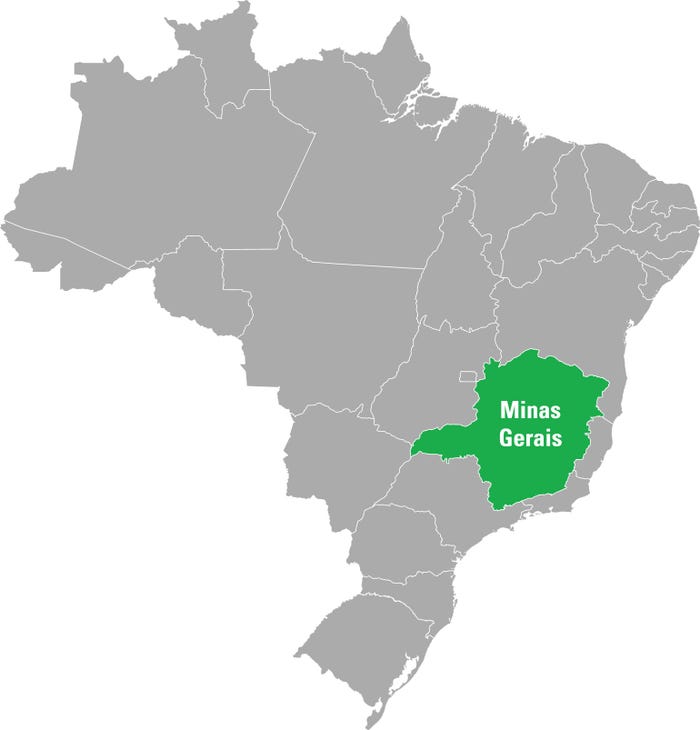
These soybean fields were planted into corn stubble in early November. Although dry weather caused early planting concerns, recent rains have given both corn and soybean crops a boost. Matthew Kruse
I spent last Sunday at our family farm in Minas Gerais, Brazil. The corn that was planted late October looks excellent and is already nearly six feet tall. They usually plant about 1,000 acres of first crop corn that goes for silage to feed their dairy.
With more rainfall, the summer crop has more yield potential than the second crop, and seems on track to surpass 200 bushels per acre unless abnormal weather takes place between now and harvest.
Much of the Brazilian frontier is planted on plateaus. The plateau that my family farms on is called Chapadão do Sao Pedro. That means the Plateau of St. Peter. St. Peter is the patron saint of harvesting. In the 44 years that they have farmed in this region, St. Peter has rarely let them down. To date, there will not be any yield loss in this area, although this is not a very large grain producing region.

While not exactly a large plateau, it has proven extremely conducive to growing crops. The soybeans were planted from early November to the first week of December. So the earliest planted soybeans are a couple of weeks away from closing their rows while the beans that were last planted have just popped up out of the ground.
Third crop: coffee
My wife and I led a tour through Brazil last January. What they learned was that this region of Brazil is also the highest concentrated area for coffee in the world. Iowa farmers often lament not having a third crop option for rotation. Here it is coffee.
Coffee trees are perennials and can last around 15 years and then they need to be replaced as yields begin to decline. This year the family has begun replacing about 10% of their total coffee area. It is a big investment and drag on the cash flow. Not just for the investment of new coffee seedlings, but also because it takes 2 ½ years before you get your first real crop. That takes a lot of patience and understanding from your banker.
This is a baby coffee tree plants being replanted on about 125 acres, roughly 10% of the total coffee area. The coffee tree is perennial and needs to be replaced roughly every 15 years. The yields start out very high in the first few seasons and then tend to drift lower over time as the tree gets older.
Brazilian beans planted
Nearly all of Brazil’s soybean crop has been planted, closing in on 94 million acres. Rains have been spotty in Mato Grosso and southern Brazil.
Bulls like to point out that there are some rough spots where yields will be severely impaired. This is true in almost every state. Parana, Mato Grosso, Minas Gerais all have dry areas this year. However, it would also be true to find areas in each of these states with excellent crop progress. Central and Northern parts of Mato Grosso have full yield potential while other parts of the state do not. This is why analysts hesitate make any drastic crop reductions just yet. It is too soon.
Brazilian soybeans being no-tilled into corn stubble in early November.
Record high prices
Nearly two-thirds of Brazil’s new crop has been forward sold as prices are at record highs. Soybean prices reached the equivalent of $14 per bushel; however, this was somewhat irrelevant as nobody has any soybeans. Brazil has begun importing small shipments from the United States, but the U.S. doesn’t have much to spare either.
Prices have started to withdraw some and should continue to withdraw as the season reaches harvest. There was a report that some farmers might try to break their forward sales contracts made at lower prices. There may be a few bad apples who do that, but most farmers will honor them. If they don’t honor those contracts, they will never be able to sell to that buyer again.
That same grain buyer may very well be financing them as well, so they would lose out on their operating loan.
Once we get to harvest and the price drops, the price difference between their forward sale price and the cash price will narrow, eliminating the impulse to break those contracts.
Corn and soybean crops got around 2.5 inches of rain last weekend.
Matthew Kruse is President of Commstock Investments. He can be reached at 712-227-1110 or by email at [email protected].
Futures trading involves risk. The risk of loss in trading futures and/or options is substantial and each investor and/or trader must consider whether this is a suitable investment. Past performance is not indicative of future results. Trading advice is based on information taken from trades and statistical services and other sources that CommStock Investments believes to be reliable. We do not guarantee that such information is accurate or complete and it should not be relied upon as such. Trading advice reflects our good faith judgment at a specific time and is subject to change without notice. There is no guarantee that the advice we give will result in profitable trades.
The opinions of the author are not necessarily those of Farm Futures or Farm Progress.
About the Author(s)
You May Also Like






